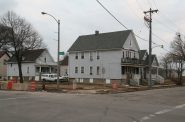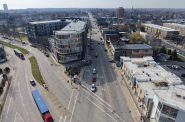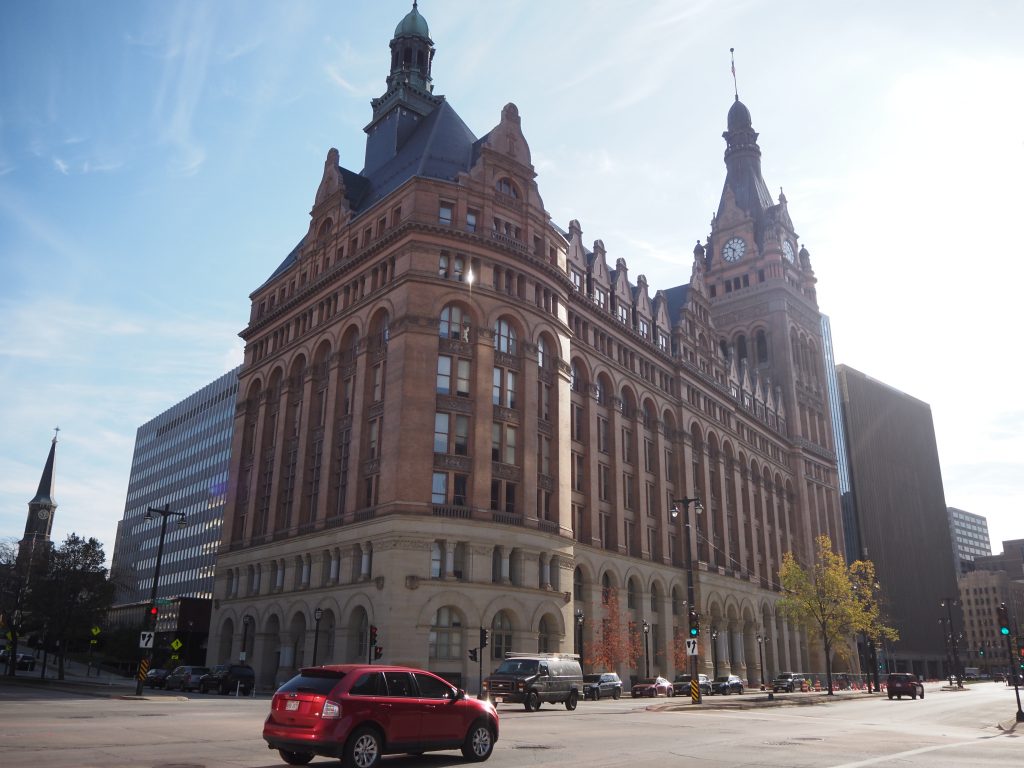Milwaukee Has Very Ambitious Climate and Jobs Plan
Alderwoman Dimitrijevic and ECO director Erick Shambarger seek to transform the city.
Milwaukee is advancing a plan to cut citywide emissions by 45% in seven years, and 100% by 2050. It would also create thousands of new jobs targeted at the city’s majority-minority population.
“Many cities internationally have bold climate plans, few have included equity,” said Alderwoman Marina Dimitrijevic, the lead sponsor of the plan, in an interview Monday. “We believe the harmful effects of climate change have disproportionately impacted our communities of color.”
The plan calls for 10 “big ideas” to achieve both the climate and equity goals. They range from strategies for making transportation and housing improvements to creating “resilience ambassadors.”
A task force, made up mostly of citizen volunteers, has been working on the plan since 2019. Now a massive infusion of federal funding could kickstart several efforts.
The city’s Environmental Collaboration Office (ECO) applied for a $40 million forestry grant to expand the city’s tree canopy. It’s also applying for a multi-million-dollar grant to build an electric vehicle charging network and eying other opportunities. The Inflation Reduction Act is expected to make billions of dollars in grant funding available to make environmentally-friendly infrastructure upgrades and ECO will use the plan to boost its applications.
“We want to set ourselves up for when money begins to trickle down,” said Dimitrijevic. “This is the time for action.”
“We have a huge opportunity with federal funds,” said Erick Shambarger, ECO director.
A contract is expected to be awarded shortly for a private vendor to construct two Net Zero model homes. It’s a pilot effort, funded by a $1 million 2021 federal grant, that would eventually lead to a house factory being developed in the central city that provides good-paying jobs and produces zero-energy homes. Seven firms bid on the initial request for proposals said Shambarger.
ECO is also working with We Energies on possibilities to expand the city’s solar energy footprint driven by changes at the state and federal level. That includes possibly expanding the College Avenue solar farm. It could allow the city to reach a 2009 goal of generating 25% of the city government’s energy needs from renewable energy. He told the council’s Zoning, Neighborhoods & Development Committee Tuesday morning that an actionable council resolution would be forthcoming.
The plan, said Shambarger and others involved in its development, isn’t intended to be put on a shelf and forgotten. “We will be convening at least once a year to document the implementation of the plan,” said the ECO director.
“This is really a key moment for city government,” said Dimitrijevic. “We are going to rebuild it right.”
“We can make a giant change as the largest city in Wisconsin and lead by example,” said Shambarger on Tuesday.
Shambarger said some of the projects identified in the plan are already underway, but the plan calls for them to be scaled up. That includes seeking more grants to redevelop paved areas at schools into more attractive and environmentally friendly natural areas.
“We have a good track record of doing this. We just really have to accelerate the pace at which we’re doing it,” said Shambarger.
Additionally, it calls for better coordination on things like lead abatement work. Weatherization work would occur alongside lead abatement work.
“Some of it is about the federal funding, some of it is about getting a little smarter about the money we already spend in our budgets,” said Shambarger. “If we’re already spending money on housing, then we should make sure the Department of City Development is including energy efficiency standards.”
It also calls for increasing housing density and providing improved non-car transportation options.
“We no longer want to be car-centric,” said Dimitrijevic. “When people say they were really highly irritated by the scooters, I was actually more irritated that we didn’t have the safe infrastructure for bike riding, pedestrians and scooters.”
“For too long we have designed the city to move cars as fast as possible, and we are seeing the consequences of that right now with reckless driving and depopulation,” said Shambarger.
Dimitrijevic said the impacts of this people-first strategy can be seen in the draft Bay View land-use plan. Other proposals in the climate plan include building a trail network along 30th Street railroad corridor, adding bus rapid transit lines and adjusting zoning laws.
“It could reduce emissions significantly,” she said.
ECO office member Pamela Ritger de la Rosa said one of the provisions of the plan calls for commercial buildings over 100,000 square feet in size to monitor their energy usage. She said efforts in other cities have found a 4% to 10% annual reduction simply because the data is being monitored.
The Inflation Reduction Act also includes a “Justice40” provision, which will direct 40% of the funding to disadvantaged communities and allow targeting within the communities. The plan’s backers say that federal requirement allows the city to avoid a looming state prohibition on diversity contracting efforts.
Will It Happen?
Alderman Robert Bauman, speaking at Tuesday’s committee meeting, said he is completely on board with the plan. But he also called the emission goals “a pipe dream” given the state political climate.
“[Mayor Cavalier Johnson] is a cheerleader for this shared revenue bill, which prohibits executing this plan,” said the alderman. The proposal would block the city from expanding the streetcar system with its own funding. “My concern is the day after it passes, what is our plan to expand electric fixed rail transit in Milwaukee?”
“All of this would be better if we had better partnerships at the state, for sure,” said Shambarger. “There are a lot of things at the state that are troublesome to me.” But he said every city faces issues with its state government, albeit not as keyed in on opposing transit expansion.
“Fortunately, we have partnerships at the federal level that support much of what we do in the plan,” said Shambarger.
“A lot of these [state legislators] that are currently up there are dinosaurs and they are going to find out in the next 10 to 15 years that they won’t be re-elected,” said committee chair Ald. Michael Murphy.
Murphy asked Shambarger if ECO had the capacity to seek all the grants that were available. “We should not be leaving any money on the table to go to Minneapolis or Chicago because we wouldn’t or couldn’t get additional staffing,” said the alderman.
“We are working as hard we can,” said Shambarger. He said it’s been “a challenge,” but thanked the council for previously approving hiring a contract grant writer.
City-County Task Force on Climate and Economic Equity members include Shambarger, Ritger de la Rosa, Ted Kraig, Freida Webb, Janet Meissner Pritchard, Julie Kerksick, Linda Frank, Pamela Fendt and Rafael Smith. The task force was initially co-chaired by alderman Nik Kovac, now the budget director, and county supervisor Supreme Moore Omokunde (now a state representative). County board chair Marcelia Nicholson, supervisor Priscilla E. Coggs-Jones and alderman Jonathan Brostoff also supported the effort. Bruce Wiggins, Jennifer A. Evans and George Martin led workgroups, but were not formally on the task force. Several dozen people participated in the task force’s efforts and are thanked in the plan.
The Common Council could formally adopt the plan on June 20. The zoning committee unanimously backed its adoption, and the Finance & Personnel Committee will review it Wednesday. It is sponsored by nine members: Dimitrijevic, José G. Pérez, Brostoff, Murphy, Bauman, JoCasta Zamarripa, Lamont Westmoreland, Mark Chambers, Jr. and Russell W. Stamper, II.
The county has yet to formally adopt the plan.
A copy of the 233-page plan is available on Urban Milwaukee. The emission reduction target is from 2018 levels.
The “10 Big Ideas”
1. Green Jobs Accelerator – Creating clear pathways to increase the number of people of color employed in family-supporting green jobs. This includes public outreach, coordination with existing training providers, clear career ladders from entry-level employment to progressively higher skills, public benefits agreements on government-funded projects, and support for businesses owned by people of color working in this field.
2. Healthy Home Energy Upgrades – Making weatherization and renewable energy retrofits more affordable as part of holistic housing improvements that also address lead-based paint and other health hazards.
3. New Net-Zero Energy Homes – Building healthy, affordable, net-zero energy homes on Milwaukee’s scattered vacant lots. The project envisions supporting a new factory in Milwaukee that constructs modular housing components year-round to both reduce the cost of new home construction and restore manufacturing job opportunities for people of color.
4. Commercial Building Energy Benchmarking + Building Performance Standards – Requiring large commercial building owners to annually track and report on their energy use and develop longer-term building performance standards to gradually reduce greenhouse gas emissions from commercial buildings.
5. People-Centered Transportation and Urban Design – Helping people drive less by improving and expanding city-wide public and active transportation options and creating thriving communities where people live, work, and play through Transit Oriented Development.
6. Electrify Transportation – Building a network of publicly-accessible EV charging stations, increasing EV adoption rates through public outreach, and transitioning municipal fleets to EVs, hybrids, and other low-emissions vehicles.
7. Greening the Electric Grid – Transitioning the electric grid to carbon-free sources of energy through advocacy for better renewable energy policy with state utility regulators, the direct purchase of renewable energy from new utility-scale projects, and expansion of rooftop solar in the city.
8. Protect and Restore Nature in the City – Protecting existing natural areas and increasing the amount of green space and trees on private and public property through expansion of the Green Schoolyards program and removal of excess asphalt in commercial parking lots that also contribute to urban heat islands
9. Food Waste Reduction – Reducing food waste and feeding hungry people through public-private partnership called FEED.
10. Resilience ambassadors – Partnering with trusted neighborhood-based organizations to connect underserved communities with available tools and resources to make their homes and neighborhoods more resilient to climate change.
Legislation Link - Urban Milwaukee members see direct links to legislation mentioned in this article. Join today
If you think stories like this are important, become a member of Urban Milwaukee and help support real, independent journalism. Plus you get some cool added benefits.
Political Contributions Tracker
Displaying political contributions between people mentioned in this story. Learn more.
- October 14, 2019 - Marina Dimitrijevic received $50 from Pamela Fendt
- October 14, 2019 - JoCasta Zamarripa received $50 from Pamela Fendt
- February 28, 2017 - Cavalier Johnson received $30 from Pamela Fendt
- June 23, 2016 - Cavalier Johnson received $25 from Pamela Fendt
- March 28, 2016 - Michael Murphy received $30 from Pamela Fendt
- March 20, 2016 - Cavalier Johnson received $25 from Pamela Fendt
- February 20, 2016 - Cavalier Johnson received $250 from Robert Bauman
- February 19, 2016 - Robert Bauman received $25 from Pamela Fendt
- May 7, 2015 - Nik Kovac received $10 from Cavalier Johnson
- November 30, -0001 - Marina Dimitrijevic received $30 from Pamela Fendt
City Hall
-
Committee Overturns Plan Commission, Recommends ‘Missing Middle’ Housing
 Apr 17th, 2025 by Jeramey Jannene
Apr 17th, 2025 by Jeramey Jannene
-
Council Committee Backs Return of Granny Flats
 Apr 16th, 2025 by Jeramey Jannene
Apr 16th, 2025 by Jeramey Jannene
-
Three-Way Standoff on Workforce Housing in Milwaukee
 Apr 15th, 2025 by Jeramey Jannene
Apr 15th, 2025 by Jeramey Jannene






















